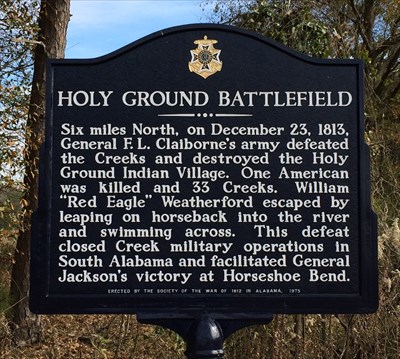The Battle of Spanish Fort Was a Huge Part of the Mobile Campaign
The Battle of Spanish Fort happened on March 27 through April 8, 1865, in what is today Baldwin County, Alabama.
It was considered to be a huge part of the Mobile campaign of the deadly Civil War between the states.
However, what is not well known is that there were technically several other forts and structures that were considered to be part of the famous fortification.
They included Fort Huger, Fort Battery, Fort Alexis, Red Fort, as well as the Old Spanish Fort, all of which were considered to be part of this historic structure.
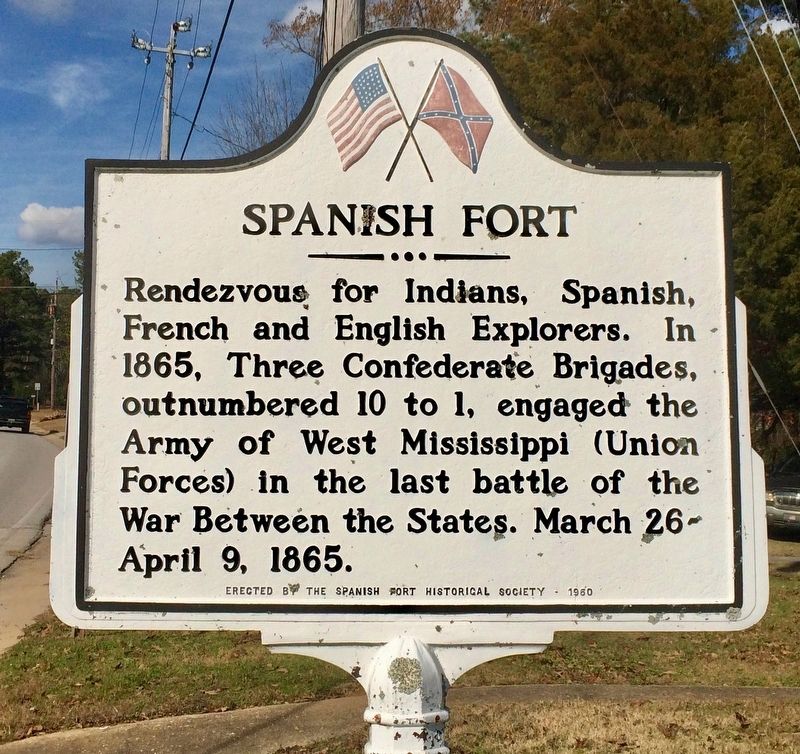 The Battle of Spanish Fort Sign
The Battle of Spanish Fort SignThe History Spanish Fort
To understand the true history of the Battle of Spanish Fort, it is helpful to understand how these majestic structures came to be.
During the colonial years, a French trading post was built in the year 1712, as well as a Spanish fort that was built much later in the year 1780.
These two structures occupied the main site of what would become the Confederate fortifications, which would eventually guard the key port city of Mobile.
By the year 1864, Confederate commander Major General Dabney Maury had built more fortifications, to help protect the City of Mobile’s western approach.
He would combine these structures with the water approaches that were defending the city, by a series of underwater obstructions and island-based artillery batteries.
To help protect Mobile’s eastern approaches, Confederate commander Major General Danville Ledbetter built another series of fortifications.
Included in these fortifications were the structures that would make up Spanish Fort, and they were built directly across the upper bay of the City of Mobile.
With Fort Blakely located about eight miles north of Spanish Fort, it would protect the northeast entry way, and when totally combined, all these fortifications were armed by over 10,000 soldiers.
The Initial Steps in the Battle of Spanish Fort
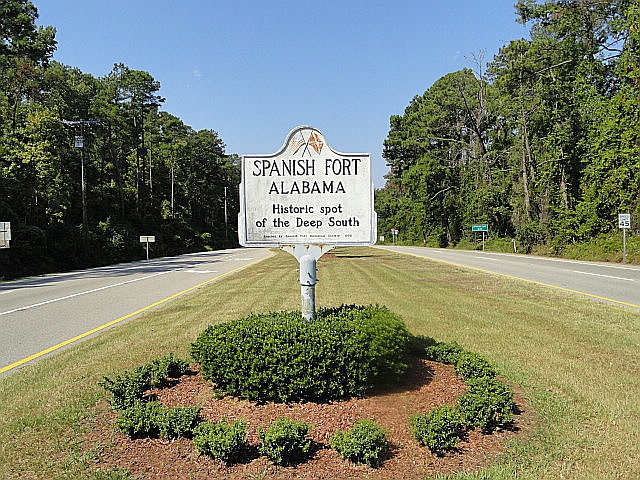 Spanish Fort Historic Marker
Spanish Fort Historic MarkerThe initial steps in the Battle of Spanish Fort were actually quite historic, for both the Union as well as the Confederate armies.
Once Union Rear Admiral David Farragut’s surprising and resounding victory at the Battle of Mobile Bay occurred on August 5, 1864, the port of Mobile was essentially closed down.
However, the Union forces needed to take control of the city, but were spread very thin, as they were spread out fighting in the siege in Atlanta, Georgia.
Because of this, they did not have the manpower to fully take the city, but this would change by early 1865.
Union Major General Edward Canby would begin to build up a large number of troops needed for this assault, but they first had to take out Spanish Fort.
The Defenses of Battle of Spanish Fort
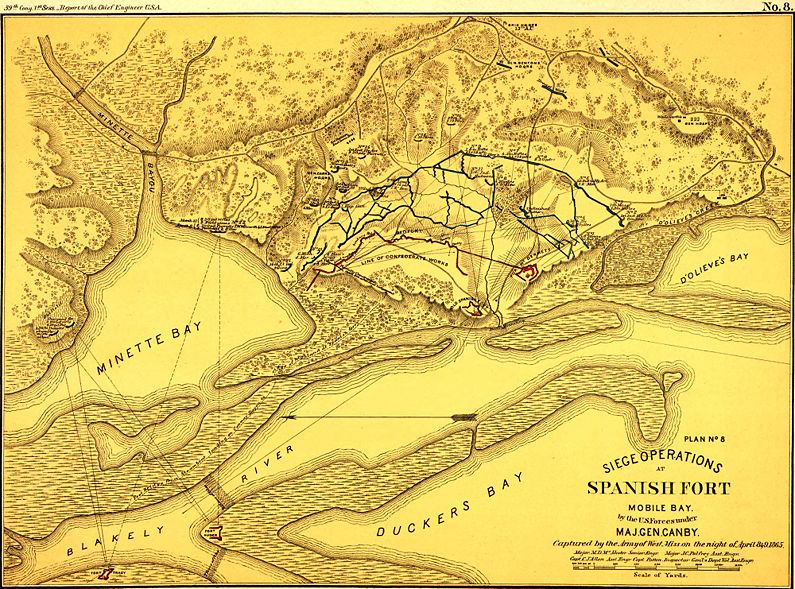 The Battle of Spanish Fort Map
The Battle of Spanish Fort MapThis task would not be easy one, however, as the defenses of Spanish Fort were considered to be very strong.
This strong fortification sat on a very high hill that had a very large flat top that ran north to south and had very steep sides.
It ran across the bay of the Blakely River, which gave it a very imposing 360-degree view of the entire surrounding area.
The Confederate commanders had also very carefully built both trenches as well as artillery redoubts in a series of semi-circles.
These semi-circles were over two miles long and over 1,000 yards wide and ran between Minette Bay and D’Olive Bay.
With Fort McDermott positioned on the southern end of this hilltop, it helped to guard all of the land approaches,
Spanish Fort and the structures that made it up helped to guard the northern end of the hill, as well as covering all of the river approaches.
The Confederate defenses that helped man all of these structures included six regiments from the Louisianan infantry, and five from the Alabama infantry.
This group of Confederate forces was heavily equipped with over 47 pieces of artillery, with 14 of them pointed at the bay in order to protect against any type of attack if it came from that direction.
However, there was one major weakness in the Confederates defense that would eventually lead to their defeat.
They had for the most part left the northern end of their defenses completely unguarded.
They had not fortified this end, because the swamps as well as the high-water table had made any type of construction very difficult.
The Battle of Spanish Fort
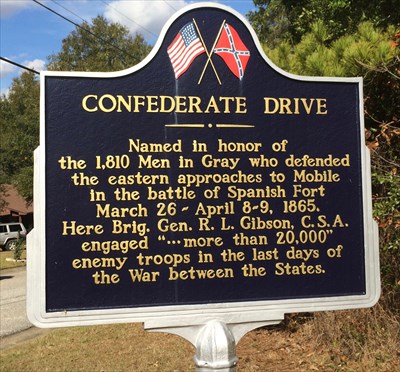 Confederate Drive Marker
Confederate Drive MarkerThe Battle of Spanish Fort technically began in early January, as Major General Dabney Maury started to build up a very large group of forces to march on the Fort.
On March 17, he had massed over 32,000 troops, which began to move steamboats from Fort Gaines over land from Fort Morgan, both of whom eventually had surrendered to the Union army.
They moved to a staging area located on the Fish River, which was about 20 miles south of Spanish Fort.
At the same time, over 13,000 Union troops started to march north as well as west, from the city of Pensacola.
Their plan was to cut off the Confederate railroad that ran from Mobile to Montgomery.
On March 24, the Union troops started to march again, and three day later, there were literally thousands of troops around these fortifications.
On March 27 the Union troops began advancing and came under fire from the Confederates.
Once this occurred, they began to circle the land approaches to the Fort and ended end about a half mile from the main strength of the Confederates.
Major General Dabney Maury understood that a full-frontal assault would most likely lead to numerous casualties, so he chose another option.
He began to dig trenches that were parallel to the Confederates main line of defense as well as their rifle pits, to help close the distance.
By doing this, he kept he kept the majority of his troops safe, however, there were still other options the Confederates had.
The commander of the Confederate Navy, Ebenezer Farrand, moved his gunboats into action.
They included the armed gunboats the CSS Huntsville, the CSS Nashville, as well as the CSS Morgan, into the Tensaw River.
This river was located statically between Spanish Fort and Fort Blakeley and offered much needed aid to the Forts under attack.
This continued for several days until the Confederates began to run out of ammunition, when everything began to change for them.
On April 8, Canby’s troops had advanced even further, and now had over 90 guns in position to fire on the Forts, and the Confederates were down to only 30 guns.
The Union attacks continued with vengeance, and about 5:00 p.m., the 8th Iowa Infantry regiment finally broke into the weak northern part of the battlefield and entreated into the Fort’s first line of defense.
By nightfall, the Confederates realized they could no longer survive the attack, and evacuated.
The Union army captured over 5,000 prisoners, as well as very large quantities of both artillery shells and gunpowder after the evacuation.
Today the Battle of Spanish Fort Battlefield is located on U.S. Highway 31 and west of State Highway 225, and the State of Alabama has erected historical sites at several key positions on the battlefield.
References
http://www.encyclopediaofalabama.org/article/h-3730
The Military History Of Alabama

Alabama Gift Store
Numerous Items for You and Your Family to Enjoy
See it here at the Gift Store
Copyright 2019-2023 Alabamabackroads.com
All Rights Reserved
